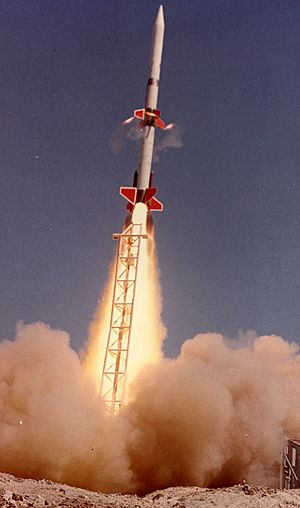Green River Launch Complex facts for kids
The Utah Launch Complex was a special place in Utah where the United States military launched rockets during the Cold War. It was a part of the larger White Sands Missile Range. Both the USAF (Air Force) and the US Army used this site to test different types of rockets.
From 1964 to 1975, many rockets were launched here. These included Pershing missiles and Athena RTV missiles. The Athena missiles carried small test warheads. These tests helped scientists learn about how missiles re-enter Earth's atmosphere at very high speeds. The complex was also known as the Green River Test Site because it was located near the town of Green River, Utah.
Contents
What Was Inside the Complex?
The Utah Launch Complex was a large area, originally covering about 3,450 acres (about 14 square kilometers). It had several different parts:
Main Area (Cantonment)
This was like the main office and living area. It had the entrance, offices for the leaders, a fire station, and places for people to live. There were also buildings for supplies and maintenance. Many people lived in trailers here, which was like a small "city of trailers."
Athena Rocket Storage
Near the main area, there were special places to store the rocket motors for the Athena missiles. These motors were very powerful and needed careful storage.
Athena Launch Pads
About five miles (8 kilometers) from the entrance, there were three concrete launch pads. Each pad had a special steel building that could move on rails. These buildings kept the rockets at the right temperature before launch.
- Green River Pad 1
- Green River Pad 2: This pad was used for 41 launches between 1964 and 1969.
- Green River Pad 3: This pad was used for 49 launches between 1964 and 1971.
Safety Zone
There was a large safety zone, about 12,000 acres (48 square kilometers), that stretched out from the launch pads. This area was for safety in case an Athena missile had a problem and fell shortly after launch.
Pershing Launch Area (Geyer Site)
This part of the complex was used for launching Pershing missiles. It had several spots where mobile launchers could be set up for firing.
Radar and Communications
There was a special site about five miles (8 kilometers) southeast of the main complex. It had radars, telemetry equipment, and other tools to track the rockets. This helped them gather information during the launches. There was also a separate tracking site on a mountain ridge.
Weather Station
The complex had a tall weather tower, about 500 feet (150 meters) high. This helped them measure wind and other weather conditions, which was important for safe rocket launches.
Other Areas
There was also a pistol range for military police training.
Nearby Support Sites
Outside the main complex, there were other important places:
- Atlantic Research Corporation Assembly Area: This was a civilian company that put together the Athena missiles. It had buildings for assembling the missiles and their payloads.
- Athena Booster Drop Zone 1: This was an area about 45 miles (72 kilometers) southeast of Green River. It was where the first stage of the Athena rocket was designed to fall after it separated from the rest of the missile. Sometimes, people living in this area had to be briefly moved for safety during launches.
Why Was It Built?
The idea for the Utah Launch Complex came from the need to test new missile technologies during the Cold War.
- In the early 1960s, the Air Force started the Athena missile program. This program was part of a bigger effort called the Advanced Ballistic Re-entry System (ABRES). The goal was to study how ballistic missiles re-entered Earth's atmosphere.
- The Green River site was chosen in September 1962 for these Athena tests.
- The US Army Corps of Engineers helped get the land ready.
- Construction began in 1963, and many buildings, roads, and utilities were built.
How It Operated
The first Athena rocket was launched from Pad 2 on February 10, 1964. However, it failed and landed near Durango, Colorado. The second launch in May also had problems. But on July 8, 1964, the first successful Athena test missile from the site landed safely at White Sands Missile Range.
Sometimes, missiles would land off course. For example, a Pershing missile landed in Mexico in 1967, and an Athena missile landed in Durango, Mexico, in 1970.
The complex also hosted launches by other countries. In 1975, a German missile wing launched its 300th Pershing missile from the site.
What Happened After?
After the last Athena launch in 1971 and the last Pershing launch in 1975, the Utah Launch Complex was no longer used for rocket launches. Pershing missile launches moved to Fort Wingate, New Mexico.
For a while, the Army rented some of the buildings to the city of Green River. The complex was mostly inactive from 1976 to 1986, and it was officially closed in 1983.
Today, parts of the land are used for other purposes. For example, some areas are now used for environmental cleanup projects. Many of the original buildings, like the strong concrete blockhouse and the launch pads, still remain.
Current Status
A part of the former launch site is now used as the Green River Uranium Disposal Cell. This site holds materials from environmental cleanup projects in the area.


